screw suitable for a variety of tools is a single-structure threaded part, including a screw body and a screw head. The outer surface of the screw body is processed with an external thread 1, and the outer side of the screw head is formed by six screw heads. Prismatic, the top surface of each edge of the outer hexagonal prism is a boss, between each boss is an end face groove 4, and the middle of each boss is provided with an end face hole 3; the inner side of the screw head is formed by six screw heads. The side surface 5 forms an inner hexagonal prism hole, and the bottom of the inner hexagonal prism hole is processed with a cross groove 12 .
The existing structure is found in the practical application experience that there are still the following problems and drawbacks: the screw structure and the screw space are combined with each other in a complementary manner, so they can provide a higher torque value, however, not every workpiece. The combination requires a high torque value, so it often results in excess quality. Although the price of the screw is low, if it can change the unchanging structure of the traditional screw, it can provide a technical means to simplify (change) the process. The effect of improving production capacity and convenience of use is indeed a technical bottleneck that the relevant industry should break through.
The technical scheme of Guangdong Yueluo Hardware Industry Co., Ltd. is: an eccentric rivet, comprising: a head, a middle part connected with the head at one end, and a tail connected with the other end of the middle part, wherein the center line of the head is connected with the tail center lines are parallel.
Bolt: A type of fastener consisting of a head and a screw (a cylinder with an external thread), which needs to be matched with a nut to fasten and connect two parts with through holes. This form of connection is called a bolted connection. If the nut is unscrewed from the bolt, the two parts can be separated, so the bolt connection is a detachable connection. [1] Stud: A type of fastener that has no head and only has external threads on both ends. When connecting, one end of it must be screwed into the part with the internal threaded hole, the other end must pass through the part with the through hole, and then the nut must be screwed on, even if the two parts are tightly connected as a whole. This form of connection is called a stud connection, which is also a detachable connection. It is mainly used for occasions where one of the connected parts is thick, requires a compact structure, or is not suitable for bolt connection due to frequent disassembly. [1] Screw: It is also a type of fastener consisting of a head and a screw. It can be divided into three categories according to the purpose: machine screws, set screws and special-purpose screws. Machine screws are mainly used for a fastened connection between a part with a fixed threaded hole and a part with a through hole, without the need for nut matching (this connection form is called screw connection, which is also a detachable connection; it can also be Cooperate with the nut, it is used for the fast connection between two parts with through holes.) The set screw is mainly used to fix the relative position between the two parts. Special purpose screws, such as eyebolts, are used for hoisting parts. [1] Nuts: with internal threaded holes, generally in the shape of a flat hexagonal column, but also in a flat square column or flat cylindrical shape, with bolts, studs or machine screws, used to fasten and connect two parts, make it a whole. [1] 5. Self-tapping screw: Similar to machine screw, but the thread on the screw is a special thread for self-tapping screw. It is used to fasten and connect two thin metal components to make them a whole. Small holes need to be made in advance on the components. Due to the high hardness of this kind of screw, it can be directly screwed into the hole of the component, so that the Forming a corresponding internal thread [1] 6. Wood screw: It is also similar to a machine screw, but the thread on the screw is a special thread for wood screws, which can be directly screwed into wooden components (or parts) to connect a band through The metal (or non-metallic) part of the hole is fastened to a wooden member. This connection is also a detachable connection. [1] 7. Washers: A type of fastener with an oblate annular shape. It is placed between the supporting surface of the bolt, screw or nut and the surface of the connecting part, which increases the contact surface area of the connected parts, reduces the pressure per unit area and protects the surface of the connected parts from damage; another type of elastic washer, It can also play a role in preventing the nut from loosening. [1] 8. Retaining ring: It is installed in the shaft groove or shaft hole groove of the machine and equipment, and plays the role of preventing the parts on the shaft or the hole from moving left and right. [1] 9. Pins: mainly used for positioning the left and right parts, and some are also used for connecting parts, fixing parts, transmitting power or locking fasteners. [1] 10. Rivet: A type of fastener consisting of a head and a shank, which is used to fasten and connect two parts (or components) with holes to make them a whole. This form of connection is called rivet connection, or riveting for short. It is a non-removable link. Because if the two parts joined together are separated, the rivets on the parts must be broken. [1] 11. Components and connection pairs: Assemblies are a type of fasteners supplied in combination, such as a combination of a certain machine screw (or bolt, self-supplied screw) and a flat washer (or spring washer, lock washer); Connection pair refers to a type of fastener that is supplied by a combination of special bolts, nuts and washers, such as high-strength hexagon head bolt connection pairs for steel structures. [1] 12. Welding nail: a heterogeneous fastener composed of a nail rod and a nail head (or no nail head), which is fixed to a part (or component) by welding, so as to be connected with other parts. .
2. Wall panel nails 1. Hardness of the heart: Standard: HRC24-45. 2. Surface hardness: Standard: HV600-800. 3. Carburized layer: 4#-6# 0.05-0.18mm, 8#-12#0.10-0.23, 14# 0.13-0.28. 4. Bending degree: the requirement is 150-450 5. Salt spray test: generally MIN 48h. 6. Torque: Specification 6#7#8#10# Torque 21283558. 3. Drilling screw 1. Hardness of the heart: Standard: HRC32-40 The actual measurement of the company's products is HRC31.7-39.0. 2. Surface hardness: Standard: HV600-700 The actual measurement of the company's products is about HV620. 3. Hard penetration layer: 4#-6#: 0.05-0.18mm 8#-12#: 0.10-0.23mm 14#: 0.15-0.28mm 4. Torque: specification, drill tail, screw, TYPE BSDTYPE CSDINCH-LBKG- CMINCH-LBKG-CM4# (2.9) 141614166# (3.5) 242824288# (4.2) 4248485510# (4.8) 6170657512# (5.5) 9210610011514# (6.3) 150173156180.
We have many years of experience in the production and sales of screws, nuts, flat washers, etc. The main products are: yin and yang round studs, carbon steel small square head bolts, 316 stainless steel screws, pan head combination bolts and other products, we can provide you with suitable products for you fastener solutions.



















 Service Hotline
Service Hotline




